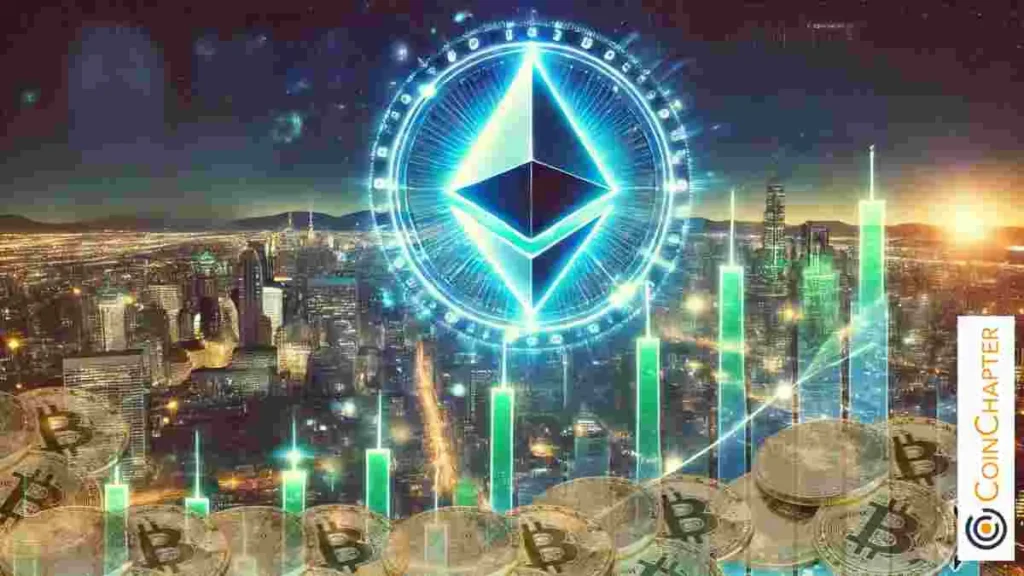Ethereum (ETH) has surged 50% over two weeks, rising to $3,744, slowing down investor attention before returning. However, ETH has been 23% below its all-time high since November 2021. At $3,730, it’s well below its historic peak, but analysts believe a much bigger move will continue.
ETH is still underestimated, data show
Despite the sudden price hike, ETH appears to be undervalued across multiple metrics. According to GlassNode, Ethereum’s MVRV Z-score (an important indicator that compares market capitalization with realisation cap) is far from past cycle peaks. The Z-score indicates that ETH has left the bear zone, but it is still below the euphoric level seen at the main top.
Compared to Bitcoin, ETH is significantly behind. Bitcoin has won 74% over the past year, while ETH has dropped by 28%. This widened the performance gap and brought BTC dominance to a historic level. Bitcoin Vector analysts say ETH is currently viewing as “underowned, undervalued and caught-up mode,” indicating a potential market rotation for Ethereum.
The main short-term goal is at the $4,000 level. This acts as both psychological and technical resistance. If ETH breaks through it, it could accelerate price momentum.
Xforceglobal analysts pointed out Elliott Wave Theory. This tracks the five-wave price cycle driven by investor psychology. ETH is likely in the third impulsive wave of this pattern, they said. If the forecast is successful, ETH could reach $9,000 in early 2026, assuming supportive macro conditions.
On-chain data reveals severe supply and growing demand
On-chain metrics also show long-term bullish pressure. Currently, more than 34 million ETH are staked, locking in 28% of the total supply. This reduces circulating supply and reflects strong investors’ trust.
At the same time, the exchange balance fell to an ETH of just 16.2 million. It’s the lowest level since 2016.
Meanwhile, demand appears to be on the rise. Since early July, GlassNode has reported a 16% jump in ETH held by its first-time buyer. This shows renewed interest from new market participants. GlassNode analysts said this was the first meaningful sign of a reversal of market trends.
Spot ether ETFs also reflect an increase in demand. Inflows have exceeded $4 billion in the last two weeks, further cutting available supplies.
Currently, 94.4% of ETH supply belongs to profit. Still, investors’ feelings have not reached euphoric levels. GlassNode’s Net Unrealized Profit/Loss (NUPL) indicator shows ETH at 0.47 with the “optimism/anxiety” zone. In comparison, both Bitcoin and Ripple are categorized into the “belief/negation” area with higher reads at 0.57 and 0.62, respectively.
Ethereum usage increases as a network scale
The value of Ethereum relies not only on speculation but on real-world use, and its use continues to increase.
The average trading fee fell to 0.0004 ETH, approaching a historic low. This drop does not mean that Ethereum is idle. Instead, it reflects better efficiency, with more activity being handled in the Layer 2 network.
Gas prices measuring calculations show a clearer image. The limit on Ethereum block gas has been repeatedly increased. Previous hikes were most recently held in July 2025, February 2025, September 2022, May 2021 and June 2020. Each time, the block is quickly filled in, suggesting a strong fundamental demand.
That pattern continued this week. After the latest block size increased, the blocks were filled again, and Ethereum was operating near full capacity, and its demand was waiting for the room to grow.
Transaction types migrate from NFT to infrastructure
The nature of Ethereum activity has changed. Once dominated in 2021, NFTs now make up a small portion of their traffic. Defi is late too. Instead, rising are activities from DAPPS in infrastructure, proof publishing, automation tools, and modular applications.
The movement of simple ETH between stubcoin transfers and addresses is also increasing. These trends indicate the growing role of Ethereum in settlements and trading, usually accompanied by bull market stages.
Ethereum continues to expand its transaction capacity while demand continues to keep pace. Combined with locked supply, new demand, and a sense of happiness from low investors, data suggests that ETH rally may not be over.
ETH forms a bullish pattern as breakouts gain momentum
The Ethereum to US Dollar (ETH/USD) chart, created on July 26, 2025, shows a bullish descending triangle pattern over a 4-hour time frame. This technical pattern is formed when the price is low but holds strong horizontal support lines. It usually shows that the buyer is building strength and that a breakout could continue on top.
Ethereum erupts from a descending triangle and is already moving upwards. At the time of the chart, the price reached $3,756, with a breakout on the line of resistance confirmed. The pattern suggests an even higher rise, and based on the height of the triangle, the predicted movement targets the breakout point about 28% up. If ETH continues this trajectory, the price could rise to around $4,832. This level matches the next marked resistance on the chart. The presence and continued support of strong volumes from the 50th 50th Exponential Moving Average (EMA) near $3,599 supports bullish outlook.
ETH RSI rebounds towards bullish zone
This Relative Strength Index (RSI) Ethereum (ETH) chart, created on July 26, 2025, shows the short-term rebounds from the neutral region. The RSI(14) line is currently read at 51.82, but its moving average is 56.60. Both values remain in the 30-70 range, indicating that ETH is not over-acquired or over-sold.
Throughout July, RSI has been primarily over 50, reflecting moderate purchasing pressure. However, it was soaked at under 40 around July 22nd, indicating short-term debilitating. Currently, the recent rise of over 50 indicates that ETH is regaining momentum. The yellow moving average line also began to flatten after decreasing. This supports potential upward movement if momentum continues.
In summary, the RSI pattern suggests that Ethereum is recovering from minor pullbacks, and it is possible that buyers can build strength if they stay active above 50 levels. A sustained push to 60-70 confirms a growing bullish momentum.



